
Fertile soils sustain plant growth by providing essential plant nutrients and favourable conditions with optimal chemical, physical, and biological properties (Figure 1).
Soil fertility is a holistic concept. Good nutrient stocks are of little use if plants cannot access them because physical issues (e.g., compaction) or chemical issues (e.g., acidity) impede uptake.
Soil fertility is more than simply supplying enough nutrients to crops. Fertile soils also have favourable chemical, physical and biological conditions for plant growth.
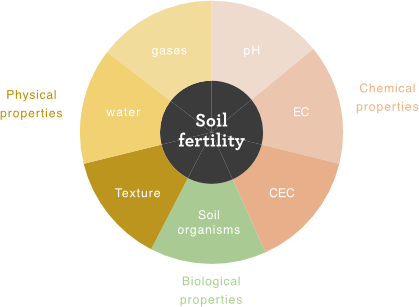
Plants need 18 essential nutrients to grow and 15 of these are provided by the soil itself (Figure 2). A fertile soil contains enough essential macro and micronutrients for optimal plant growth.
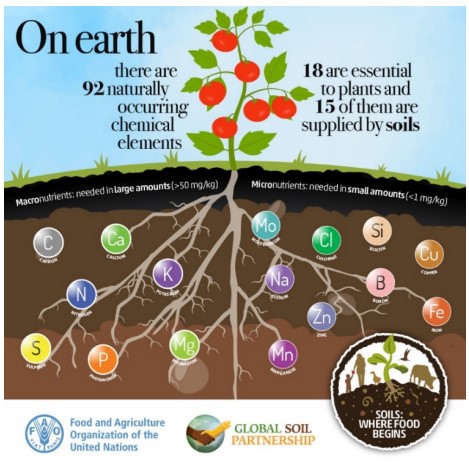
Soil cation exchange capacity (CEC) is a measure of the soil's ability to hold positively charged ions (cations) such as calcium (Ca²⁺), magnesium (Mg²⁺), potassium (K⁺), and ammonium (NH₄⁺), and exchange them with other cations in the soil solution.
The higher the CEC, the more cations or nutrients the soil can hold, leading to greater soil fertility. CEC is a large part of soil fertility as it determines the amount of nutrients a soil can hold and release for plant uptake.
The CEC is determined by the soil's clay and organic matter content, which provides negatively charged sites for cations to attach to.
CEC varies depending on clay per cent, the type of clay, organic matter, and soil pH. Generally, the more organic matter and/or clay in a soil, the higher the CEC. Sandy soils typically have a low CEC due to their low clay and organic matter content. Different clay
minerals have different CEC’s. For example, smectite has a higher CEC than kaolinite.
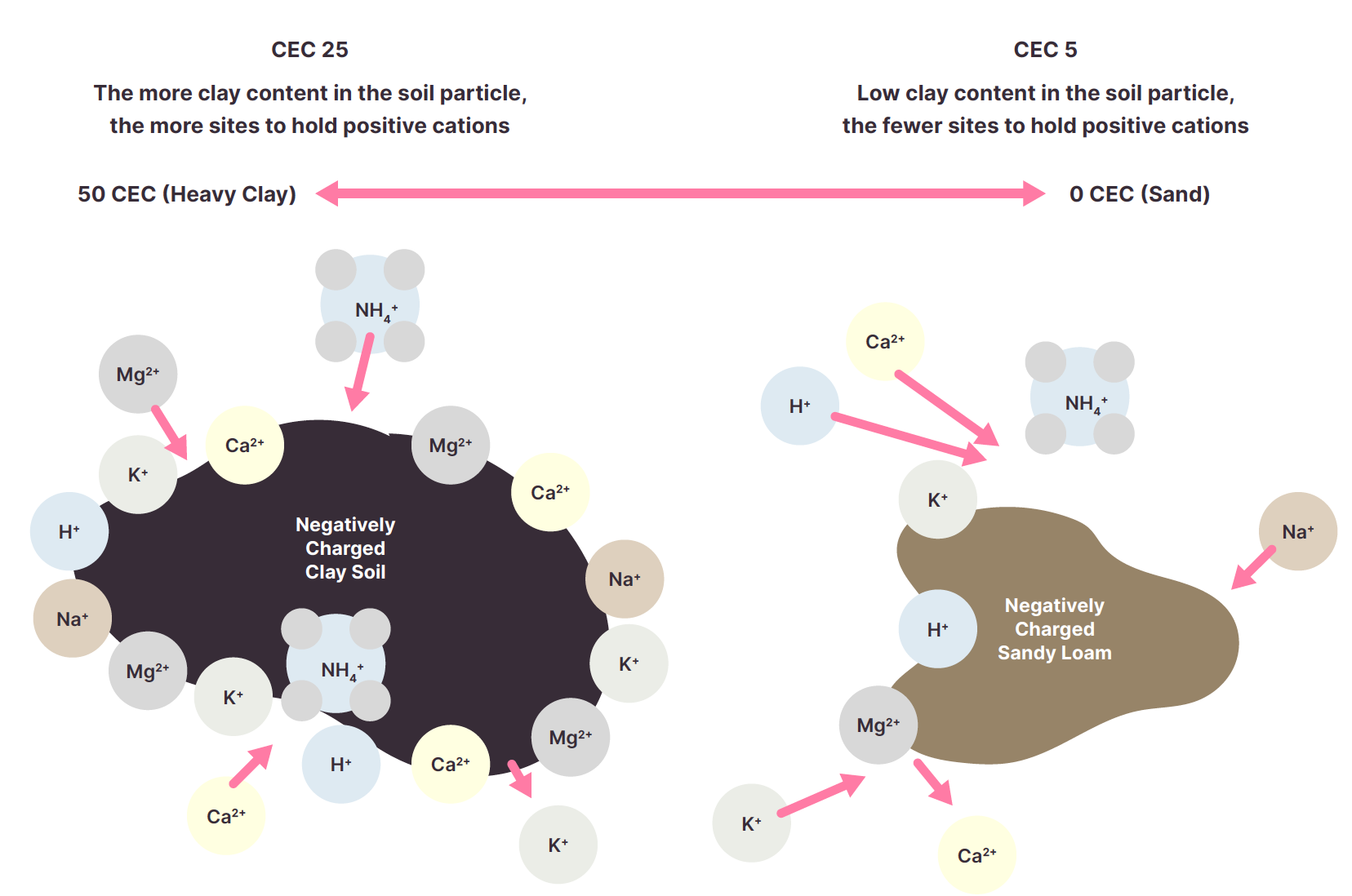
Soil organic matter lies at the heart of soil fertility. As well as influencing a soil’s ability to hold nutrients, soil organic matter:
Soil pH, a measure of acidity or alkalinity, plays a crucial role in nutrient availability. Nutrients are more available (easier for plants to take up) when soil pH is around 6 – 6.5. As soil pH becomes more acidic, nutrient such as nitrogen and phosphorus are harder to take up, while manganese and aluminium can become toxic in a very acidic soil. In alkaline soils, trace elements such as molybdenum and iron can become deficient.
The more saline a soil, the harder it is for crops to take up water and therefore nutrients.
Soil structure is an important part of soil fertility, affecting water holding capacity, drainage, and nutrient availability within the soil. Well-structured soils have both macro and micro pores, and sturdy aggregates, which help water and gases flow through the soil. This promotes root development, nutrient uptake, and microbial activity, all of which contribute to healthy plant growth. Poorly structured soils, such as compacted soils, make life difficult for crops roots by limiting access to water and nutrients.
Fertile soil hosts a diverse community of beneficial microorganisms, such as bacteria, fungi, earthworms and collembola. These micro – and macro - organisms play vital roles in decomposing and processing organic matter, fixing nitrogen, and enhancing nutrient availability for plants.
Maximising crop productivity and profitability is the most common driver of soil fertility management. Nutrient deficient soils produce nutrient deficient plants, penalising crop yields and quality. Overapplication of nutrients is an unnecessary cost that affects the bottom line and leads to waste.
Excessive nutrient applications can contribute to water pollution, such as eutrophication in rivers and lakes. By applying nutrients precisely based on plant needs, farmers can reduce the risk of nutrient runoff, leaching, and subsequent environmental impacts. This approach safeguards water resources and protects ecosystems.
Fertile soils are more resilient to environmental stresses such as drought, extreme temperatures, and pests. Healthy soils with a diverse microbial population enable crops to better withstand adverse conditions.
Balancing nutrient inputs and outputs from the paddock is a large part of managing soil fertility.
This section describes the main nutrient flows in agricultural paddocks, including common inputs, nutrient cycles within the paddock, and how nutrients leave the paddock. Understanding the main changes and when/why they happen is important to
manage crop nutrition and minimise environmental losses and waste. Nutrient losses are discussed in detail in section ‘how soil fertility declines’
Figure 4 outlines the main processes to consider when managing nutrients.
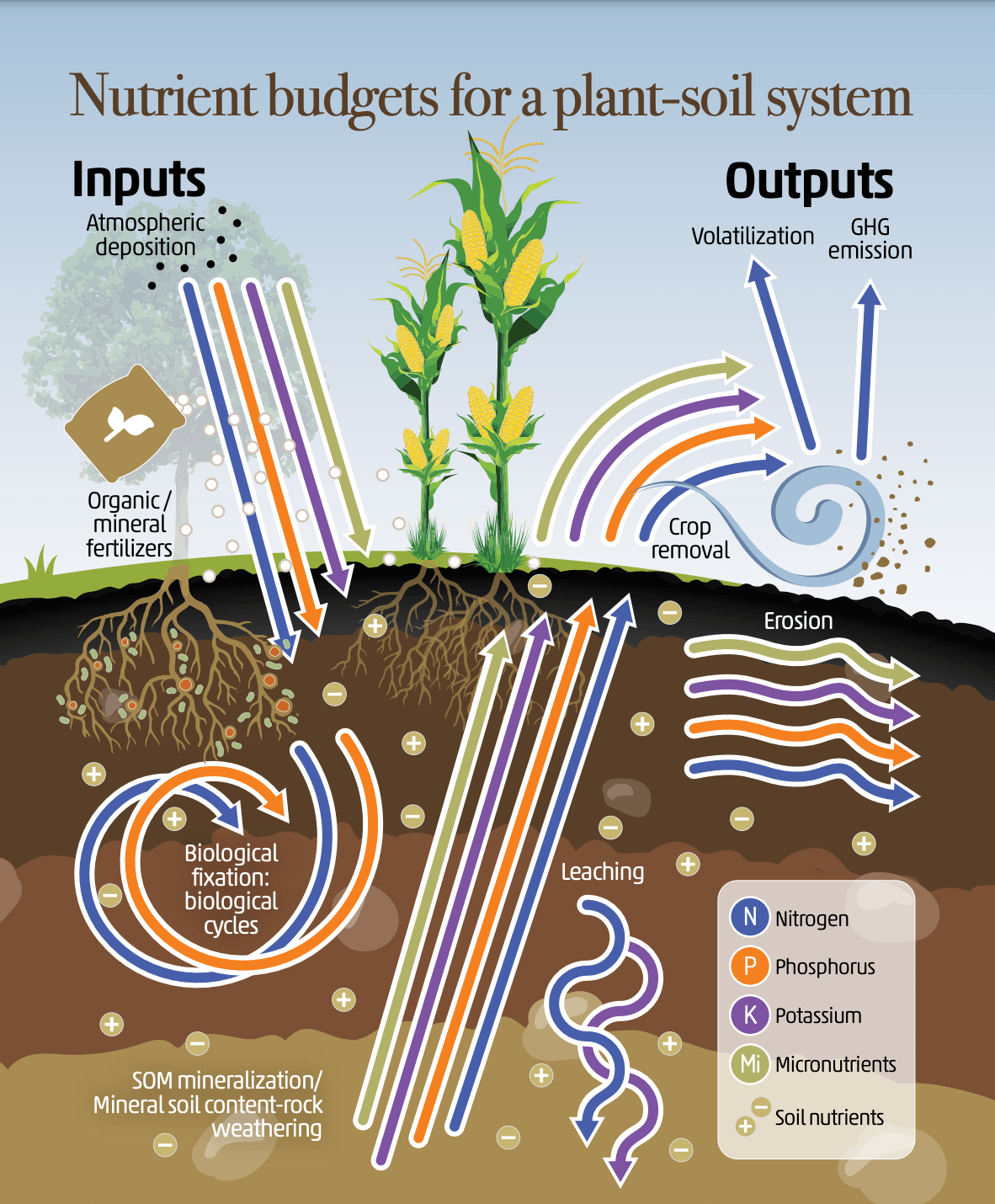
Fertilisers are the most common nutrient inputs and essential to achieve the yields we expect. Fertilisers are often a large part of the annual budget, accounting for up to 30% or more of variable input costs. As such, optimal fertiliser use is critical to minimise costs while maximising outputs. In terms of inputs, fertilisers need the most careful management as they have the greatest risk of nutrient losses and mismanagement, with environmental and economic consequences.
Inorganic or mineral fertilisers are mined or manufactured. Urea made from synthesised ammonia is a common example. These fertilisers are typically formulated to contain specific amounts of nutrients, and the nutrients are often readily available for plant uptake, making it easier to address nutrient deficiencies immediately. Some nitrogen fertilisers contain inhibitors that slow the conversion of nitrate forms to minimise nitrogen losses. See denitrification and volatilisation in section 4.
Organic fertilisers are derived from living or once-living things, such as plants and animals. There is a very wide range of potential organic fertilisers sources (see table below). ‘Wastes’ such as manure and composts are common sources of organic fertilisers. Organic fertilisers release nutrients slowly over time as they are broken down by microorganisms in the soil. They often contain a wide range of nutrients but are highly variable and can contain contaminants.
For decades, mineral fertilisers have accounted for most of the fertilised applied to crops. In 2015-2016, urea and ammonium phosphate were the most commonly used fertilisers in Australia, accounting for 47% and 38% of total nitrogen-based fertilisers.*
While mineral fertilisers are still more common, organic fertilisers are becoming more popular. There are pros and cons of each, and many growers find a combination of the two can work well.
Up to half of the nitrogen in your body has been manufactured by the Haber-Bosch process.

Legume crops can transfer nitrogen from the atmosphere into the soil. Rhizobium bacteria live in the soil as well as the plant. When they attach to the roots of legumes, they produce nodules that capture nitrogen from the atmosphere and incorporate it into the soil as ammonia, ready for crop use.
The amount of nitrogen legumes can fix varies widely (0 – 400kgN/ha) and depends on the:
Most legumes are inoculated with Rhizobia to improve nodulation. Rhizobia are very sensitive to heavy metals and acidic (pH<5) or alkaline pH. Maintaining the optimum soil pH is important to encourage nodulation and nitrogen fixation, and therefore managing soil fertility.
For more information see Inoculating legumes: practice and science.
After harvest, the remaining crop residues such as stems, leaves and roots contain nutrients that can be recycled back into the soil. Crop residues breakdown faster if they are incorporated into the soil as they are in contact with soil microbes.
However, as microbes break down crop residues, they use (or immobilise) soil nitrogen, making it unavailable for crop use. The higher the carbon: nitrogen ratio of the residue, the more nitrogen microbes need to break it down. A C:N ratio >22:1 leads to immobilisation. Legume stubbles typically have a C:N ratio of 35:1, while wheat stubbles are around 80:1. Immobilisation alsoincreases with higher stubble loads.
Sometimes, adding nitrogen fertiliser is necessary to help the break down process. Nitrogen budgets that account for soil nitrogen levels, stubble loads, and crop needs are important to estimate fertiliser needs.
Green manures are crops grown with the intention of incorporating them back into the soil or leaving them on the soil surface to decompose and add organic matter and nutrients. Leguminous green manures, such as clover or vetch, offer additional benefits through nitrogen fixation. Faba beans, soybeans and lablab are grown in NSW as both forage crops and a green manure.
Key point: nutrients exist in different forms in the soil. Plants can only take up nutrients in their inorganic form.
Nutrients can exist in multiple forms in the soil and are stored in different places, including in soil organic matter, when adsorbed to clay, in soil minerals, soil water and in plant root exudates.
Nutrients move through different pools and change form, affecting their availability to crops. Many complicated chemical and biological factors control these changes, and scientists don’t yet fully understand how every nutrient cycle works. What matters is knowing the main nutrient cycles in the soil and how they affect nutrient availability, as this in turn influences fertiliser decisions.
For example, consider the simple different pools of phosphorus in Figure 6. In the soil, phosphorus is found in multiple different pools including as organic P, in primary minerals, adsorbed to clays and iron and aluminium oxides and carbonates, as secondary compounds, and a small amount is soluble P, in the water ready for crops to use. Phosphorus moves in and out of the different pools, and crops can only take up the phosphorus in the soil solution. Generally, only about 20 – 30% of the P fertiliser applied in any one year is available for crop use. The rest is bound by the soil, used by microbes, and incorporated into organic matter.
This information, along with knowing a soil’s ability to lock up phosphorus (phosphorus buffering index, module 2), soil phosphorus levels and crop needs, will guide fertiliser decisions.
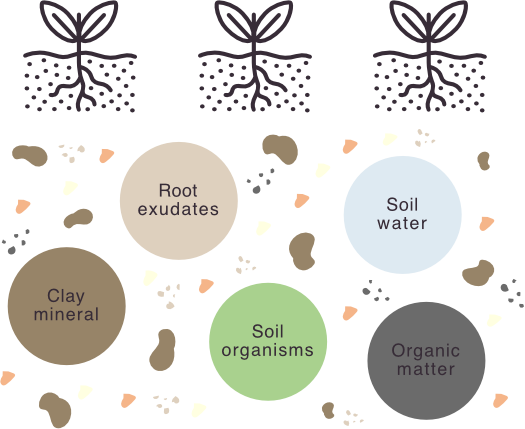
Figure 5. Where nutrients are stored in the soil.
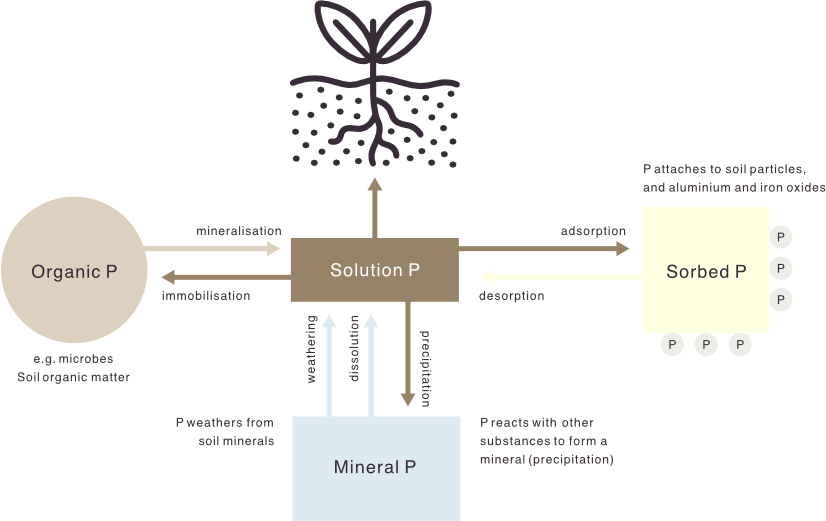
The two main pools of nutrients are organic and inorganic. Crops can only take up the inorganic forms of nutrients when they are dissolved in the soil water. Some of the inorganic nutrients are not available for crops either, such as phosphorus sorbed to clay surfaces (Figure 6). Crops cannot take up organic forms of nutrients, but these can become plant-available over the season through mineralisation (see below).
Soil organic matter mineralisation and immobilisation Soil organic matter acts as a reservoir of nutrients, providing a supply throughout the season for plant uptake – providing conditions are right. Nutrients stored in organic matter are not readily available for plant uptake and need to be mineralised (released). This happens when microbes decompose the organic matter.
The ideal conditions for mineralisation are those that encourage microbial activity – good soil moisture and oxygen, and warm temperatures. These mineralised nutrients can be an important source of in-crop nutrition, but it is tricky to predict how fast and how much nutrient will become available. In animal production systems, manure is an important source of phosphorus for the next crop.
As a general rule-of-thumb, for every ton of carbon (C) in soil organic matter, about 100 kilograms (kg) of nitrogen, 15 kg of phosphorus and 15 kg of sulphur becomes available to plants as the organic matter is broken down (DPIRD, 2022).
Nutrient immobilisation is the opposite of mineralisation. Inorganic nutrients are converted back into organic forms by microbes and become unavailable for plant uptake.
Soil minerals contain nutrients, including phosphorus and potassium. Minerals weather (breakdown over time) and eventually release nutrients into the soil solution for plant uptake. This release is typically quite slow.
There are a variety of other nutrient cycling processes that affect availability over the season. For example, phosphorus can bind irreversibly to the surface of clay particles or iron and aluminium oxides (adsorption) where it becomes unavailable for plant uptake.
An internet search will reveal multiple websites that go into much greater detail on the various nutrient cycles. Ag Vic has videos on the nitrogen cycle and phosphorus cycling in a grazing system. The University of Hawai’i has a very detailed description phosphorus cycling.
Nutrients are removed from the paddock either in the harvested crop or are unintentionally lost through processes such as erosion.
These are discussed in more detail in the next section ‘how soil fertility declines’.
Soil organic matter decline and nutrient loss is a big part of soil fertility decline, however anything that reduces soil quality can contribute to soil fertility decline. This section describes the main causes of soil fertility decline. Management options are discussed in section 6.
In farming, nutrients are ‘lost’ when they are no longer in the paddock for crop use. In reality they are not lost, they have just gone somewhere that is inaccessible to the crops. Limiting nutrient loss plays a big role in maintaining soil fertility. While all nutrients can be lost, some are more prone to loss than others, particularly nitrogen.
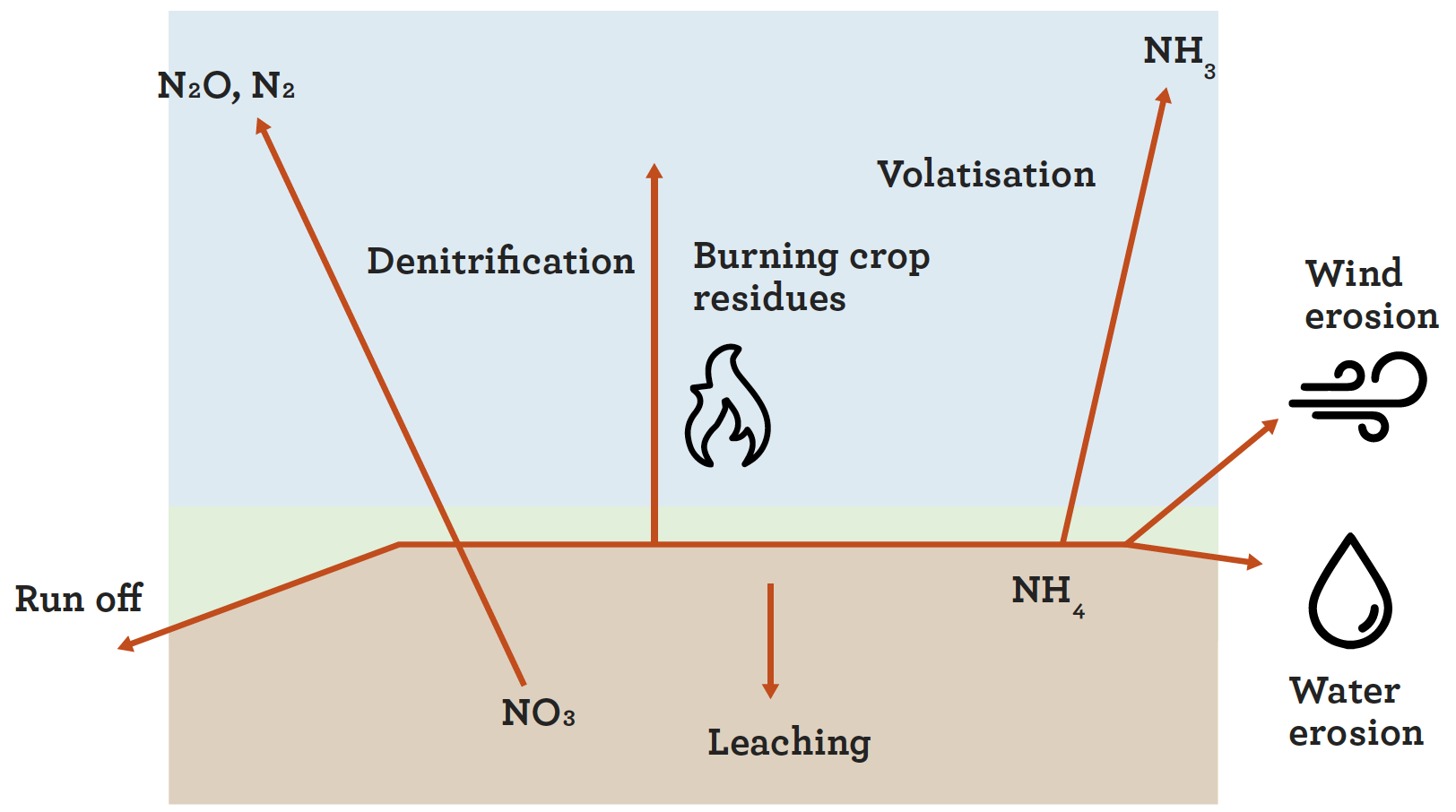
Leaching is when nutrients are washed deeper into the soil and out of the rootzone. Leaching risk increases with nutrient mobility. Nitrate and sulphate are highly mobile and leach easily. Phosphorus is quite immobile in the soil until levels of phosphorus rise above the ability of the soil to bind it (the phosphorus buffering index). Trace elements are also typically less prone to leaching, however, excessive nutrients applications and rainfall or irrigation will encourage leaching.
Nutrients leaching into the groundwater can have environmental impacts such as eutrophication.
Nutrient runoff is similar to leaching in that nutrients dissolved in water wash out of the paddock. Nutrient runoff, particularly phosphorus (P), has affected waterway health in many regions of Australia, causing algal blooms and fish kills.
Wind and water erosion physically remove soil from the paddock, taking nutrients and organic matter with them. Erosion risk is higher on:
High cereal stubble loads can make weed management, seeding, and trafficability a challenge. Burning is one way to reduce the stubble load but means the nutrients in the stubble are lost to the atmosphere. Up to 80% of nitrogen, 50 – 80% of sulphur and 40% of phosphorus and potassium can be lost during a burn. Further nutrients are lost when the ash blows off the paddock. Burning stubble also reduces soil organic matter and carbon, and comes with erosion risk, particularly if the next season is a dry one and low biomass crops don’t provide enough soil cover.
Volatilisation is when nitrogen is lost to the atmosphere as ammonia and other gases. It is more common when urea fertiliser is used, as ammonium-N is very rapidly converted to ammonia gas. This generally happens at the soil surface and is not a risk if urea is incorporated.
Denitrification occurs when nitrate is lost to the atmosphere as nitrogen gas as either N2 or nitrous oxide (a greenhouse gas). It frequently occurs in anaerobic soils, when the soil is waterlogged. Soil microbes run out of oxygen and some can use the oxygen from the nitrate to survive, releasing the remaining N as gas. Denitrification, however, can happen anywhere in the soil, not just at the surface, as in the case of volatilisation.
Over time, if nutrients exported at harvest and lost are not replaced, overall soil nutrients stocks will run down, lowering soil fertility.
Soil organic matter lies at the heart of soil fertility. It is important not just as a store of nutrients, but is a food source for soil microbes, to maintain soil structure, water holding capacity, and generally makes a more resilient soil.
The main culprits for soil organic matter decline are:
Soil degradation through compaction, acidification and salinisation also affect soil fertility.
Compacted soil makes it harder for crop roots to grow and access the water, nutrients and oxygen needed for root growth. Similarly, acidification and salinisation make it difficult for crops to take up the nutrients they need for optimal growth.

Assessing soil fertility is crucial for successful agriculture and sustainable land management. It involves evaluating the soil's ability to support plant growth and provide essential nutrients. There are three main aspects to assessing soil fertility.
You can’t manage what you don’t measure. The aspects of soil fertility that can be tested at the laboratory include:
Soil structure and compaction are best assessed in the field. These are discussed more in module 4.
While in the field, visual observations of plant growth, including patchy or stunted growth, could indicate soil fertility issues. Use these to help guide soil testing. Information on how to sample soil for laboratory testing and where to send samples for testing can be found in Module 1.
Soils are not created equal. Every soil has a different capability to support specific land uses and activities without undergoing degradation. For example, you wouldn’t expect an acidic sandy soil to have the same productive potential as a well-structured clay with high organic matter. The same idea applies to soil fertility.
Set reasonable expectations for each soil on the farm based on its current condition and the budget available to improve the various aspects of soil fertility. Consider at least the top 30cm of soil.
For example, the table below notes which aspects of this topsoil could be addressed to improve soil fertility. Soil pH is acidic and organic matter is low.
Deeper soil tested revealed the soil is compacted at about 30cm, and exchangeable sodium is elevated. The next steps would be to check if the soil is dispersive, and if so, add gypsum to address the problem.
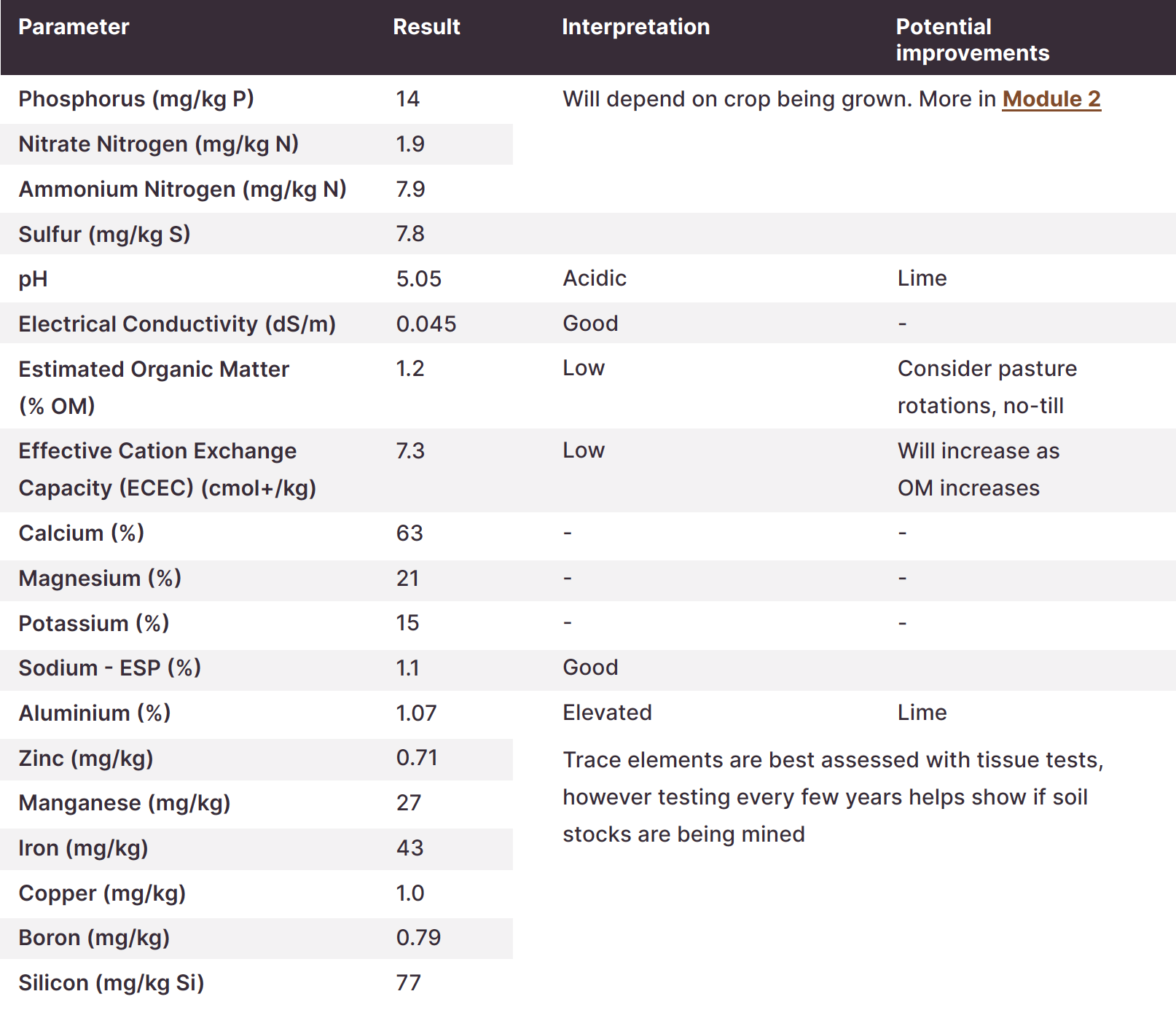
Improving soil fertility is an ongoing process. Parameters you can influence in the short term are pH, structure (dispersion, compaction), and nutrient content.
Improving soil organic matter and CEC takes many years, unless sources of organic matter such as compost are applied.
Determine how frequently you will monitor soil fertility. Monitoring annually or at the beginning of each growing season is generally sufficient, but the frequency may vary depending on specific needs and the rate of change in soil conditions.
Follow a consistent sampling method to collect soil samples from different parts of the field. Take samples using appropriate and clean tools at the same depths each time to ensure accurate comparisons over time.
Maintain detailed records of soil test results, management practices, and crop performance to compare the current results with previous years' data. These records will help you make informed decisions in the future and provide valuable insights for long-term soil fertility management. This allows you to track changes in soil fertility and identify trends over time.
By regularly monitoring soil fertility and implementing appropriate corrective measures, you can maintain healthy and productive soil, leading to improved crop yields and sustainable land management practices.
Managing soil fertility means maintaining or even improving soil organic matter, soil structure, soil pH, and fine-tuning nutrient inputs. It requires a holistic view of the soil, not just fertiliser budgets.
Maintaining soil fertility requires optimising physical, chemical and biological soil properties.
Regulates nutrient availability As pH increases, so does CEC Microbial activity slows down in acidic soil
Soil test and calculate lime rates to keep pH in the ideal range for the crop. More in module 4.
Crops struggle to take up water and nutrients in saline soil
Test irrigation water before irrigating, and monitor soil salinity levels if using saline water
Maintain soil cover to stop dryland salinity forming
Plant salt tolerant species if necessary to maintain groundcover
Well-structured soils promotes root development, nutrient uptake, and microbial activity, contributing to healthy plant growth.
Limit compaction:
Do not drive on the soil when it’s wet
Convert to Controlled traffic farming (CTF)
Minimise tillage*
Alleviate existing compaction:
Rip highly compacted soils. Note ripping works well on broadacre sandy soils,
and becomes less effective as soil clay content increases
Apply gypsum if the soil is dispersive to improve aggregation
Soil organic matter plays one of the largest roles in soil fertility, by improving soil water holding capacity, structure, is a food source for soil microbes, and is a reservoir of nutrients.
Limit erosion
Optimise crop biomass and yield to maximise crop carbon inputs into the soil
Include pastures, legumes, green and/or brown manures in crop rotations
Retain and incorporate crop residues into the soil
Add compost or other organic materials if economically viable.
Minimise tillage*
Microbes:
- drive nitrogen fixation, mineralisation, and some nutrient transformations to make more nutrients available for uptake - help build soil organic matter by decomposing organic matter
Improve soil organic matter
Maintain ideal pH, low salinity and good soil structure
Keep soil covered – crop roots release exudates that feed microbes
Nutrient loss from paddocks is a major source of soil fertility decline and adverse environmental impacts.
See ‘how to reduce nutrient losses from’ below
Follow the 4Rs of nutrient management. Use nutrient budgets and soil tests to apply the right rate of fertiliser in the right place, in the right form and at the right time.
Maintain ground cover, whether through stubble retention, cover crops, or green manure crops, and managing grazing.
Direct drill into cover crops to keep groundcover
If cropping soil has been ameliorated and is bare, there are a variety of techniques to minimise wind erosion
Limit runoff
Maintain soil organic matter to bind soil particles
These are discussed more in Module 5: Building healthy soils and Module 8: Controlling soil disturbance and erosion.
Crop rotations help break soilborne pest and disease cycles, manage weeds, and if growing legumes, improve soil nitrogen.
Pasture phases is crop rotations are the most effective way of improving soil organic matter (without physically importing organic matter).
Include legumes in crop rotations
Regular soil testing will show if any aspect of soil fertility is declining and needs intervention.
See Section 5
*Strategic tillage might be necessary to mix stratified nutrients, alleviate compaction, and incorporate lime to depth